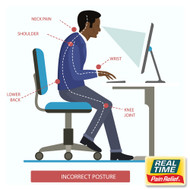The Ergonomic Challenge: A Blueprint for a Healthier Work Lifestyle
1st Feb 2024
In the digital age, where a significant portion of our lives is spent working at desks or in front of computers, ergonomic issues have emerged as silent culprits contributing to discomfort and pain. This article explores the impact of poor posture, incorrect lifting techniques, and the consequences of ignoring ergonomic principles at work.
Poor Posture: The Domino Effect on Health
Poor posture is a pervasive issue, often exacerbated by the prolonged hours spent sitting at desks or hunched over electronic devices. Slouching, rounded shoulders, and tilting the head forward can lead to musculoskeletal imbalances, causing pain in the neck, shoulders, and lower back.
The spine, designed to maintain an S-shaped curve, is adversely affected by prolonged periods of poor posture. This misalignment strains the supporting muscles and ligaments, potentially resulting in chronic pain. Additionally, poor posture can compromise lung capacity and digestion, emphasizing the far-reaching impact of how we position our bodies throughout the day.
Incorrect Lifting Technique: Safeguarding Against Back Pain
Improper lifting techniques are a common cause of back pain and injury. Lifting heavy objects at work or during daily activities while using the wrong technique can place excessive strain on the spine, leading to acute or chronic pain.
The key to safe lifting lies in maintaining a neutral spine, engaging the core muscles, and distributing the weight evenly. Ignoring these principles can result in injuries to the back, shoulders, and even the knees. Workplace training programs emphasizing proper lifting techniques can significantly reduce the risk of lifting-related injuries.
Ignoring Ergonomics at Work: A Recipe for Discomfort
As we spend a substantial portion of our lives in professional settings, the design of our workspaces significantly impacts our physical well-being. Ignoring ergonomic principles in office setups can contribute to a host of health issues.
Unsuitable chair height, poorly positioned computer monitors, and inadequate keyboard placement are common ergonomic pitfalls. These factors can lead to discomfort, eye strain, and repetitive strain injuries. Over time, the cumulative effect of these issues may result in conditions such as carpal tunnel syndrome, tendonitis, or even chronic back pain.
Conclusion:
By cultivating awareness of the importance of good posture, correct lifting techniques, and ergonomic considerations at work, individuals can take proactive measures to safeguard their musculoskeletal health. Implementing ergonomic adjustments in work environments, undergoing training on proper lifting techniques, and incorporating posture-improving exercises into daily routines can collectively contribute to a healthier and pain-free work lifestyle.
Resources/References:
Mayo Clinic. (2021). "Office ergonomics: Your how-to guide."
National Institute for Occupational Safety and Health (NIOSH). (2021). "Musculoskeletal Disorders and Workplace Factors."
Occupational Safety and Health Administration (OSHA). (2021). "Ergonomics."
Spine-health. (2021). "Good Posture Helps Reduce Back Pain."
American Chiropractic Association. (2021). "Lift Right: Preventing Back Injuries."





